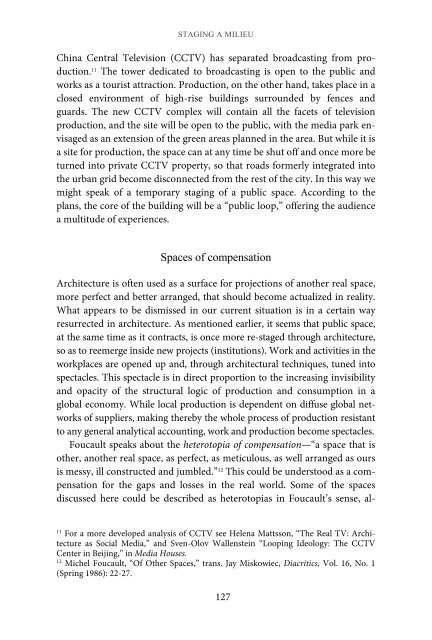Foucault, Biopolitics, and Governmentality
Foucault, Biopolitics, and Governmentality
Foucault, Biopolitics, and Governmentality
Create successful ePaper yourself
Turn your PDF publications into a flip-book with our unique Google optimized e-Paper software.
STAGING A MILIEU<br />
China Central Television (CCTV) has separated broadcasting from production.<br />
11 The tower dedicated to broadcasting is open to the public <strong>and</strong><br />
works as a tourist attraction. Production, on the other h<strong>and</strong>, takes place in a<br />
closed environment of high-rise buildings surrounded by fences <strong>and</strong><br />
guards. The new CCTV complex will contain all the facets of television<br />
production, <strong>and</strong> the site will be open to the public, with the media park envisaged<br />
as an extension of the green areas planned in the area. But while it is<br />
a site for production, the space can at any time be shut off <strong>and</strong> once more be<br />
turned into private CCTV property, so that roads formerly integrated into<br />
the urban grid become disconnected from the rest of the city. In this way we<br />
might speak of a temporary staging of a public space. According to the<br />
plans, the core of the building will be a “public loop,” offering the audience<br />
a multitude of experiences.<br />
Spaces of compensation<br />
Architecture is often used as a surface for projections of another real space,<br />
more perfect <strong>and</strong> better arranged, that should become actualized in reality.<br />
What appears to be dismissed in our current situation is in a certain way<br />
resurrected in architecture. As mentioned earlier, it seems that public space,<br />
at the same time as it contracts, is once more re-staged through architecture,<br />
so as to reemerge inside new projects (institutions). Work <strong>and</strong> activities in the<br />
workplaces are opened up <strong>and</strong>, through architectural techniques, tuned into<br />
spectacles. This spectacle is in direct proportion to the increasing invisibility<br />
<strong>and</strong> opacity of the structural logic of production <strong>and</strong> consumption in a<br />
global economy. While local production is dependent on diffuse global networks<br />
of suppliers, making thereby the whole process of production resistant<br />
to any general analytical accounting, work <strong>and</strong> production become spectacles.<br />
<strong>Foucault</strong> speaks about the heterotopia of compensation—“a space that is<br />
other, another real space, as perfect, as meticulous, as well arranged as ours<br />
is messy, ill constructed <strong>and</strong> jumbled.” 12 This could be understood as a compensation<br />
for the gaps <strong>and</strong> losses in the real world. Some of the spaces<br />
discussed here could be described as heterotopias in <strong>Foucault</strong>’s sense, al-<br />
11 For a more developed analysis of CCTV see Helena Mattsson, “The Real TV: Architecture<br />
as Social Media,” <strong>and</strong> Sven-Olov Wallenstein “Looping Ideology: The CCTV<br />
Center in Beijing,” in Media Houses.<br />
12 Michel <strong>Foucault</strong>, “Of Other Spaces,” trans. Jay Miskowiec, Diacritics, Vol. 16, No. 1<br />
(Spring 1986): 22-27.<br />
127


